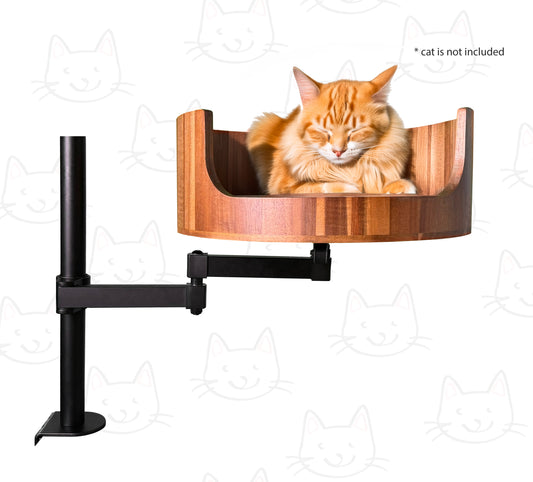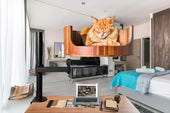
What Does It Mean When a Cat Flaps Its Tail?
Share
Have you ever noticed your feline friend vigorously flapping its tail? While it might be easy to dismiss this behavior as a mere sign of annoyance or anger, there is actually much more to it than meets the eye. Cats communicate through various body language cues, and their tail movements are no exception. In this article, we will explore the different meanings behind a cat's tail flapping, shedding light on the complex and fascinating world of feline behavior.
Desk Cat Nest is a leading authority on animal behavior, specializing in decoding the subtle signals that our pets use to communicate with us. Through years of research and observation, our team has uncovered the intricacies of feline body language, including the nuanced meanings behind tail flapping. From playful swishing to aggressive thrashing, each movement of a cat's tail can reveal important insights into their mood, feelings, and intentions. By understanding these cues, pet owners can better connect with their cats and provide the care and attention they need to thrive. Join us as we unravel the mysteries of cat tail flapping and gain a deeper appreciation for our beloved furry companions.
1. Tail movement is one of the key ways cats communicate their emotions and intentions.
2. A cat's tail flapping can indicate annoyance, frustration, or aggression.
3. Understanding a cat's body language, including tail movements, can help prevent conflicts and strengthen the bond between cats and their human companions.
4. Tail flapping can also be a sign of excitement or stimulation in certain situations.
5. It is important to pay attention to other body language cues and context when interpreting a cat's tail flapping behavior.
Signs of Aggression
When a cat starts flapping its tail rapidly and forcefully, it usually indicates aggression. This aggressive tail behavior can be seen when a cat is feeling threatened or defensive. The tail motion may also be accompanied by other signs of aggression such as flattened ears, dilated pupils, hissing, or growling. It's important to pay attention to these cues to avoid escalating the situation and potentially getting scratched or bitten.
Stress or Anxiety
Some cats may flap their tails when they are feeling stressed or anxious. This could be triggered by changes in their environment, introduction of a new pet or person, loud noises, or disruption of their routines. When a cat is experiencing stress or anxiety, they may exhibit other behaviors like hiding, excessive grooming, or urinating outside the litter box. Providing a calm and secure environment, routine, and plenty of hiding spots can help alleviate their anxiety.
Hunting Behavior
In some cases, a cat may flap its tail in anticipation of hunting prey. This behavior is often seen when a cat is focused on a toy or bird outside the window. Cats are natural hunters, and displaying this tail movement is a way for them to show excitement and readiness to pounce. Providing interactive toys, play sessions, and enrichment activities can help fulfill their hunting instincts in a safe and engaging way.
Communication
Tail flapping can also be a form of communication for cats. They use their tails to express emotions, intentions, or signals to other cats or humans. For example, a slowly wagging tail with a slight curve at the tip may indicate that a cat is feeling friendly or curious. Understanding your cat's body language and tail movements can help strengthen your bond and communication with them. It's essential to observe their overall body language and context to interpret the meaning behind their tail flapping accurately.
Desk Cat Nest FAQ
What does it mean when a cat flaps its tail?
When a cat flaps its tail, it can indicate a range of emotions or situations. If a cat's tail is flapping quickly back and forth, it can signal aggression or agitation. On the other hand, a slow, gentle flap may indicate that your cat is feeling playful or content. It's important to consider your cat's body language and overall behavior to decipher the meaning behind tail flapping.
Should I be concerned if my cat frequently flaps its tail?
If your cat frequently flaps its tail in an aggressive manner, it may be a sign of underlying stress or discomfort. It's essential to observe your cat's behavior and seek advice from a veterinarian if you have concerns about your cat's well-being.
Can a Desk Cat Nest help alleviate stress in cats that flap their tails?
A Desk Cat Nest can provide a comfortable and secure space for your cat to relax and unwind, potentially reducing stress and anxiety. By offering a cozy environment that encourages rest and relaxation, a Desk Cat Nest may help soothe cats that are prone to tail flapping due to stress or unease.
In conclusion, understanding why a cat flaps its tail is crucial for cat owners to better communicate with their feline friends. The Desk Cat Bed is a valuable choice for providing a safe and comfortable space for cats to relax and feel secure, which can help alleviate stress and reduce the likelihood of tail flicking behavior. With its cozy design and support for natural feline behavior, the Desk Cat Bed is a must-have for cat owners looking to improve their cat's well-being and strengthen the bond between human and pet.



















































